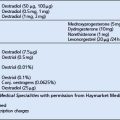CHAPTER 9 DERMATOLOGY
SKIN MALIGNANCIES
MALIGNANT MELANOMA
Diagnosis
ACNE
Management
Moderate acne
Oral antibiotics.
Hormonal treatment
BACTERIAL SKIN INFECTIONS
VIRAL SKIN INFECTIONS
WARTS
FUNGAL SKIN INFECTIONS
RINGWORM (TINEA)
GENERALISED PRURITUS
Where there is no obvious skin disease, all patients with persistent generalised pruritus should be investigated to exclude an underlying systemic disorder. Scabies is a common cause – burrows can be difficult to see (see p. 142).
Arrange FBC, ESR, LFTs, C&Es, fasting BS, TFTs, urine for protein and a CXR.
EXCESSIVE SWEATING
LOCALISED TO THE AXILLAE, PALMS AND SOLES
ECZEMA
Management
General.
Sympathetic explanation is essential, especially to the parents of young children with atopic eczema. Assess possible irritants or trigger factors with a view to avoidance, if possible, e.g. contact with metals, detergent or woollen clothing, dietary factors, emotion, heat, cold. If appropriate, give details of local and national support groups (see p. 358). The skin should be kept clean and warm, and prolonged contact with water, detergent, etc. should be avoided. If the hands are affected, gloves should be worn at the sink etc.
Topical steroids.
Other treatments.
The role of diet in atopic eczema is contentious. Cow’s milk is the most commonly implicated food, and should be avoided for the first 6 months of life. Exclusion diets help a small number of children, and should only be undertaken with expert advice from a dietician.
PSORIASIS
In total, 1.5% of the population are affected by this chronic inflammatory skin disease during their lifetime. It most commonly presents as multiple, large, well-demarcated, red plaques with thick silvery scales in a symmetrical distribution, often involving elbows, knees and scalp. Nails may be pitted. There is no cure and it is usually lifelong, with exacerbations and remissions. The patient should therefore be given detailed information on self-management. The Psoriasis Association can be helpful (see p. 358).
Psoriasis is often exacerbated by trauma, stress or infections.
STABLE PLAQUES
Management
SCABIES
OTHER SKIN INFESTATIONS
CRAB LICE
These are capable of living in all hair except scalp hair, which is too dense for them. The most common site is pubic hair. They are transmitted by close physical contact, usually sexual. Infection of children is not evidence of sexual abuse. Use aqueous preparations of e.g. malathion over the whole body. Instructions for use are as for head lice.



